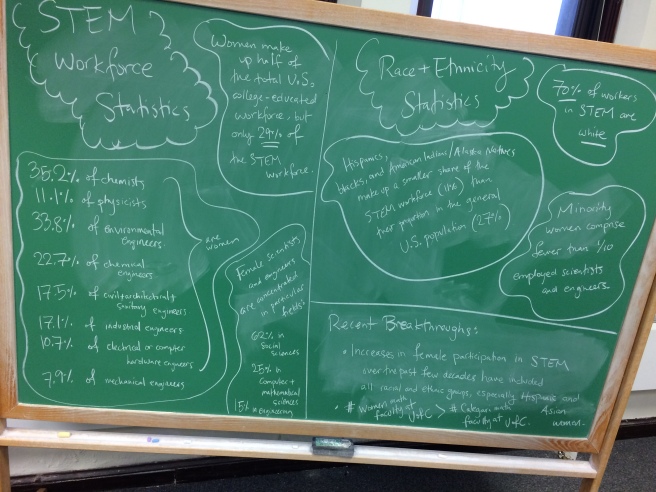On Thursday I helped run a Wine and Cheese event in the math department, hosted by the UChicago chapter of the AWM. The goal of the event was to bring the community together, and try to encourage conversation about women in math. We offered snacks and drinks, a venue for conversation, and filled the chalk boards with statistics about women in math, and STEM fields more generally. Perhaps the most interesting aspect of these statistics is that men and women are approximately equally represented in math in high school and earlier, but start to disappear from the math community as time goes on. Perhaps this indicates a problem with the attrition rate (prompting questions like, “Why are so many women leaving math?” and “How can we adapt the norms of the math community to make it easier for women to stay?”). But on the other hand, it may indicate that we are finally turning a corner in getting women interested in math, and all that is needed now is time for the current class of high-schoolers to start to permeate the upper levels of academia. The way to tell would be to look at similar statistics from several decades ago, but I don’t know where to find such information.

We were moderately successful in prompting conversations on women in math. I overhead several groups discussing whether representation of women in math was something that needed to be “fought” for. This reminded me of an excellent post by Vi Hart and Nicky Case. They created applets the show how even a very slight preference for living with “people like you” leads to segregated communities. It also shows that it takes an active desire for integration to overcome existing segregation. While their original intent was to use this as a parable about racial segregation in housing, I think it also applies to issues of under-representation in math (and other academic fields, more generally). Given that math is a primarily male field, it will take an active desire to include women – women will need to embrace working in a (currently) male-dominated field, and men will need to embrace the diversity that women offer.

It’s good to get so many people together and talking about something that is usually avoided. It’s hard to talk about representation of women, or to talk about historical female figures in mathematics. I have heard many comments along the lines of, “It’s not fair how easy it is for women to get into the top graduate programs,” , or “That historical female mathematician gets more credit than she deserves.” In addition to being incredibly discouraging personally (did I only get into graduate school because I’m a woman?), the former (1) is simply wrong if you consider the percentage of graduate students who are male versus the percentage who are female, and (2) ignores the difficulty of remaining in math long enough to even apply for graduate school. While the former is more difficult to hear as a woman in math, I think the latter is more insidious. It forgets that much of the work women did was published (with or without permission) by men, and credit was given to the male authors. Perhaps the most famous example of this in a STEM field is the work by Rosalind Franklin that was used without citation (and possibly without permission, though this is disputed) by Watson and Crick. Part of the reason for this was at least partially due to the misogynistic views of Watson toward Franklin. It also forgets that many women were explicitly banned from membership in mathematical societies, denied university diplomas (if they were even allowed to attend university), and therefore unable to support themselves as mathematicians unless they were independently wealthy. And this of course ignores the usual lack of education of women and societal expectations that women would be uneducated, quiet, and family-focused. In this context, a woman producing any math is impressive, even if it is not the most incredibly unique work of the time.

All of this is to say, I’m excited for the Women in Math symposium the UChicago AWM is hosting next week. Most of the speakers will actually be talking about historical female mathematicians or their work, and I’m looking forward to hearing how this is presented.
